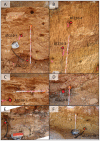New luminescence ages for the Galería Complex archaeological site: resolving chronological uncertainties on the acheulean record of the Sierra de Atapuerca, northern Spain
- PMID: 25338076
- PMCID: PMC4206284
- DOI: 10.1371/journal.pone.0110169
New luminescence ages for the Galería Complex archaeological site: resolving chronological uncertainties on the acheulean record of the Sierra de Atapuerca, northern Spain
Abstract
The archaeological karstic infill site of Galería Complex, located within the Atapuerca system (Spain), has produced a large faunal and archaeological record (Homo sp. aff. heidelbergensis fossils and Mode II lithic artefacts) belonging to the Middle Pleistocene. Extended-range luminescence dating techniques, namely post-infrared infrared stimulated luminescence (pIR-IR) dating of K-feldspars and thermally transferred optically stimulated luminescence (TT-OSL) dating of individual quartz grains, were applied to fossil-bearing sediments at Galería. The luminescence dating results are in good agreement with published chronologies derived using alternative radiometric dating methods (i.e., ESR and U-series dating of bracketing speleothems and combined ESR/U-series dating of herbivore teeth), as well as biochronology and palaeoenvironmental reconstructions inferred from proxy records (e.g., pollen data). For the majority of samples dated, however, the new luminescence ages are significantly (∼50%) younger than previously published polymineral thermoluminescence (TL) chronologies, suggesting that the latter may have overestimated the true burial age of the Galería deposits. The luminescence ages obtained indicate that the top of the basal sterile sands (GIb) at Galería have an age of up to ∼370 thousand years (ka), while the lowermost sub-unit containing Mode II Acheulean lithics (base of unit GIIa) was deposited during MIS 9 (mean age = 313±14 ka; n = 4). The overlying units GIIb-GIV, which contain the richest archaeopalaeontological remains, were deposited during late MIS 8 or early MIS 7 (∼240 ka). Galería Complex may be correlative with other Middle Pleistocene sites from Atapuerca, such as Gran Dolina level TD10 and unit TE19 from Sima del Elefante, but the lowermost archaeological horizons are ∼100 ka younger than the hominin-bearing clay breccias at the Sima de los Huesos site. Our results suggest that both pIR-IR and single-grain TT-OSL dating are suitable for resolving Middle Pleistocene chronologies for the Sierra de Atapuerca karstic infill sequences.
Conflict of interest statement
Figures







References
-
- Carbonell E, Bermúdez de Castro JM, Parés JM, Pérez-González A, Cuenca-Bescós G, et al. (2008) The first hominin of Europe. Nature 452: 465–470. - PubMed
-
- Arsuaga JL, Martínez I, Garcia A, Carretero JM, et al. (1997) Sima de los Huesos (Sierra de Atapuerca, Spain). The site. J Hum Evol 33: 109–127. - PubMed
-
- Meyer M, Fu Q, Aximu-Petri A, Glocke I, Nickel B, et al. (2014) A mitochondrial genome sequence of a hominin from Sima de los Huesos. Nature 505: 403–406. - PubMed
-
- Bermúdez de Castro JM, Arsuaga JL, Carbonell E, Rosas A, Martínez I, et al. (1997) A hominid from the Lower Pleistocene of Atapuerca, Spain: possible ancestor to Neandertals and modern humans. Science 276: 1392–1395. - PubMed
-
- Rodríguez J, Burjachs F, Cuenca-Bescós G, García N, Van der Made J, et al. (2011) One million years of cultural evolution in a stable environment at Atapuerca (Burgos, Spain). Quat Sci Rev 30: 1396–1412.
Publication types
MeSH terms
LinkOut - more resources
Full Text Sources
Other Literature Sources
Miscellaneous

